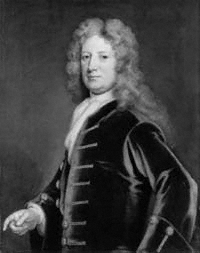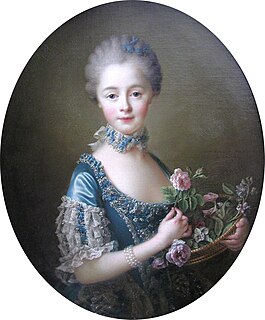
Baron de Ros of Helmsley is the premier baron in the Peerage of England, created in 1288/89 for William de Ros, with precedence to 24 December 1264. Premier baron is a designation and status awarded to the holder of the most ancient extant barony of the Peerage of England. The present premier baron is Baron de Ros. Before the Dissolution of the Monasteries the Prior of the Order of St John in England was deemed premier baron.

Baron de Clifford is a title in the Peerage of England. It was created in 1299 for Robert de Clifford (c.1274–1314), feudal baron of Clifford in Herefordshire, feudal baron of Skipton in Yorkshire and feudal baron of Appleby in Westmoreland. The title was created by writ, which means that it can descend through both male and female lines. The Norman family which later took the name de Clifford settled in England after the Norman Conquest of 1066 and was first seated in England at Clifford Castle in Herefordshire. The first Baron served as Earl Marshal of England but was killed at the Battle of Bannockburn in 1314. His 8th generation descendant the 11th Baron, was created Earl of Cumberland in 1525, whose grandson the 3rd Earl was a noted naval commander. On the latter's death in 1605 the earldom passed to his younger brother, the 4th Earl.
Baron Herbert is a title in the Peerage of England. It was created by writ in 1461 for William Herbert, who was later made Earl of Pembroke. The second Earl of Pembroke surrendered his earldom in return for the earldom of Huntingdon, which became extinct on his death without male issue. The barony, however, passed to his daughter Elizabeth, who later married the first Earl of Worcester. At Elizabeth's death, the title passed to her son, who later inherited his father's earldom of Worcester. Later, the fifth Earl was made Marquess of Worcester, and the third Marquess became Duke of Beaufort. Thereafter, the barony and dukedom remained united until 1984 when, upon the death of the tenth Duke without issue, the barony fell into abeyance. Then, in 2002, the Queen terminated the abeyance of the barony of Herbert in favour of the last holder's great-nephew, David John Seyfried.

Baron Wharton is a title in the Peerage of England, originally granted by letters patent to the heirs male of the 1st Baron, which was forfeited in 1729 when the last male-line heir was declared an outlaw. The Barony was erroneously revived in 1916 by writ of summons, thanks to an 1844 decision in the House of Lords based on absence of documentation. As such, the current Barony of Wharton could more accurately be listed as a new Barony, created in 1916, with the precedence of the older Barony.

Baron Berners is a barony created by writ in the Peerage of England.

Baron Dacre is a title that has been created three times in the Peerage of England, every time by writ.
Baron Darcy de Knayth is a title in the Peerage of England. It was created in 1332 for John Darcy with remainder to his heirs general, allowing daughters to inherit.

Earl of Yarborough is a title in the Peerage of the United Kingdom. It was created in 1837 for Charles Anderson-Pelham, 2nd Baron Yarborough.
Baron Furnivall is an ancient title in the Peerage of England. It was originally created when Thomas de Furnivall was summoned to the Model Parliament on 24 June 1295 as Lord Furnivall. The barony eventually passed to Thomas Nevill, who had married the first baron's descendant Joan de Furnivall, and he was summoned to parliament in her right. Their daughter, Maud de Neville, married John Talbot, who was also summoned to parliament in her right. He was later created Earl of Shrewsbury. On the death of the seventh earl in 1616, the barony fell into abeyance. The abeyance was terminated naturally in favour of the earl's daughter Alethea Howard in 1651 and passed through her to the Dukes of Norfolk. On the death of the ninth Duke in 1777, the barony again fell into abeyance. In 1913 the abeyance was terminated again in favour of Mary Frances Katherine Petre, daughter of Bernard Petre, 14th Baron Petre. Through her father she was a great-great-great-granddaughter of the ninth Baron Petre and his first wife Anne Howard, niece of the ninth Duke of Norfolk, who became co-heir to the Barony on her uncle's death in 1777. On Lady Furnivall's death in 1968 the barony fell into abeyance for the third time.
Baron Fauconberg is an hereditary title created twice in the Peerage of England.
The title Earl of Holderness also known as Holdernesse existed in the late 11th and early 12th centuries as a feudal lordship and was officially created three times in the Peerage of England namely in 1621, in 1644 as a subsidiary title to that of the then-Duke of Cumberland and in 1682. The official creations lasted 5, 38 and 96 years respectively.

Marcia Amelia Mary Pelham, Countess of Yarborough and 13th Baroness Conyers and 7th Baroness Fauconberg, OBE was a British peer who worked in politics for the Conservative Party.

Violet Ida Eveline Herbert, Countess of Powis and suo jure16th Baroness Darcy de Knayth was a British peeress in her own right.

Amelia Osborne, Marchioness of Carmarthen, 12th Baroness Darcy de Knayth, 9th Baroness Conyers, 5th Countess of Mértola, was a British peer and a Portuguese countess.
The title Count of Mértola was granted to Frederick, 1st Duke of Schomberg by Afonso VI of Portugal, in 1663, as a reward for the Duke's service with the Portuguese Army.
Sackville George Pelham, 5th Earl of Yarborough, MC, styled Lord Worsley from 1914 to 1926 and known as The Lord Conyers from 1926 until his accession to the earldom in 1936, was a British peer and soldier.
Diana Mary Miller, 11th Countess of Mértola, 15th Baroness Conyers, 9th Baroness Fauconberg was the eldest daughter of Sackville Pelham, 5th Earl of Yarborough.
Sackville George Lane-Fox, 12th Baron Conyers and de jure 15th Baron Darcy de Knayth was a British peer and soldier.
Conyers Darcy, 1st Baron Darcy of Meinhill, 7th Baron Darcy de Knayth and 4th Baron Conyers was a British noble and father of the 1st Earl of Holderness.

George Charles Herbert, 4th Earl of Powis DL JP, known as George Herbert until 1891, was a British peer.










